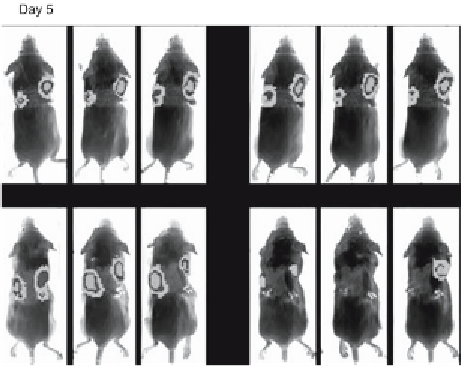Biology Reference
In-Depth Information
Fig. 2. Real-time
in vivo
bioluminescence monitoring of
S. aureus
Xen-29 in the
mouse model of soft-tissue biofilm infection during treatment with rifampin. Effect of
4 days of rifampin treatment (twice a day with 30 mg/kg) on a 3-week-old biofilm.
A representative animal from the group receiving antibiotic or the untreated infected
group is shown. Note the response to treatment including relapse that can be monitored
non-invasively within the same animal throughout the study period. (
See
Color Plate 7,
following p. 46.)
proteins in promoting bacterial adhesion to biomaterials in initial phase of
blood-material interaction. An inoculum of
10
3
-10
5
CFUs of
S. aureus
Xen-
29 and
P. aeruginosa
Xen-5 per catheter results in a reproducible, localized
persistent infection surrounding the catheter until the termination of the exper-
iment on day 25-50. Doses above 10
6
CFUs/catheter for
P. aeruginosa
and
10
8
CFUs/catheter for
S. aureus
result in 100% mortality. An inoculum of
≤
∼
10
5
/catheter produces chronic infections.
3.7. Catheter-Associated Urinary Tract Infections
UTIs are one of the most common bacterial infections in humans. Most
of these infections follow instrumentation of the urinary tract, mainly urinary
catheterization (
see
Fig. 3
), with the development of catheter-associated
bacteriuria directly related to the duration of catheterization
(18)
. BPI easily
allows spatial information to be monitored sequentially throughout the entire
disease process, from cystitis to ascending UTIs (
see
Fig. 4
and Color Plate 8,
following p. 46), as well as treatment efficacy and relapse in diseased or
asymptomatic animals all without exogenous sampling
(10)
.





































Search WWH ::

Custom Search